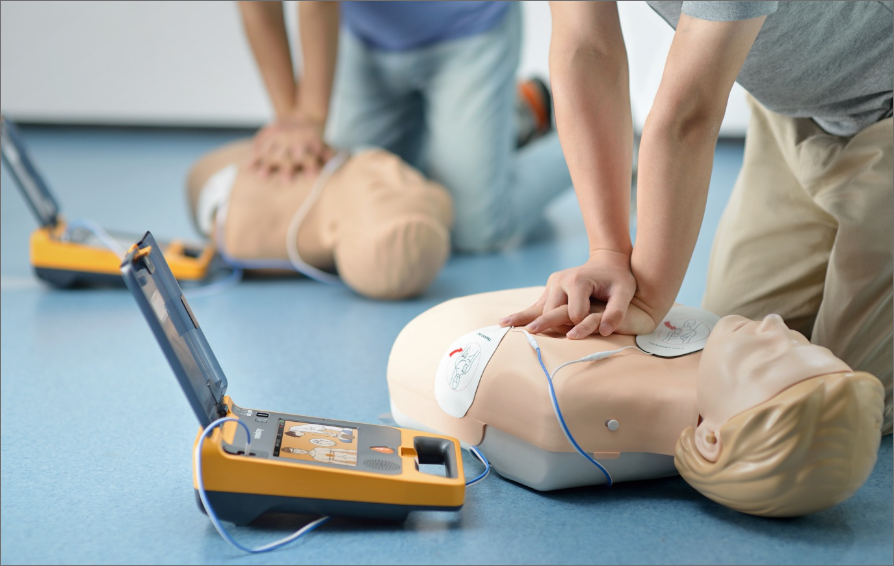When someone suffers sudden cardiac arrest, every second counts. The combination of CPR with AED creates a powerful life-saving approach that can dramatically increase survival rates. Understanding how these two critical interventions work together is essential for anyone who wants to be prepared to save lives.

Understanding the Critical Connection Between CPR with AED
Cardiopulmonary resuscitation (CPR) and automated external defibrillators (AEDs) serve complementary roles in emergency cardiac care. While CPR maintains blood circulation and oxygen delivery to vital organs, an AED can restore the heart’s normal rhythm when it’s in a life-threatening arrhythmia.
The statistics are compelling. When CPR is performed immediately after cardiac arrest, survival rates can double or triple. However, when CPR with AED is used together within the first few minutes, survival rates can increase to 70% or higher. This dramatic improvement occurs because the two techniques address different aspects of cardiac arrest simultaneously.
CPR keeps blood flowing to the brain and other critical organs, preventing irreversible damage that begins within four to six minutes. Meanwhile, an AED analyzes the heart’s electrical activity and delivers precisely timed electrical shocks to restore normal rhythm. This coordinated approach creates the optimal conditions for successful resuscitation.
The Science Behind Effective CPR with AED Integration
During sudden cardiac arrest, the heart typically enters one of two dangerous rhythms: ventricular fibrillation or ventricular tachycardia. These chaotic electrical patterns prevent the heart from pumping blood effectively. CPR with AED targets both the mechanical and electrical problems simultaneously.
High-quality chest compressions during CPR create artificial circulation, pushing oxygenated blood through the body. The American Heart Association emphasizes that compressions should be at least two inches deep for adults, delivered at a rate of 100 to 120 compressions per minute. This mechanical action maintains perfusion to vital organs while the AED prepares to address the electrical malfunction.
Modern AEDs use sophisticated algorithms to analyze heart rhythms and determine when defibrillation is appropriate. When the device detects a shockable rhythm, it charges automatically and prompts the rescuer to deliver the shock. The electrical energy disrupts the chaotic rhythm, allowing the heart’s natural pacemaker to potentially resume normal function.
Step-by-Step Protocol for CPR with AED Implementation
The integration of CPR with AED follows a specific sequence that maximizes effectiveness. First, assess the victim’s responsiveness and breathing. If the person is unresponsive and not breathing normally, immediately begin CPR while someone else retrieves the AED.
Start chest compressions immediately, placing the heel of one hand on the lower half of the breastbone, with your other hand on top. Push hard and fast, allowing complete chest recoil between compressions. Continue CPR until the AED arrives and is ready for use.
Once the AED is available, turn it on and follow the voice prompts. Most devices will instruct you to attach the electrode pads to the victim’s bare chest. One pad typically goes on the upper right chest, below the collarbone, while the other is placed on the lower left side, below the left nipple.
The AED will then analyze the heart rhythm. During this analysis, ensure nobody is touching the victim. If a shock is advised, make sure everyone is clear before pressing the shock button. After delivering the shock, immediately resume CPR with AED protocols, starting with chest compressions.
Timing and Coordination in CPR with AED Procedures
Effective CPR with AED requires precise timing and coordination. The goal is to minimize interruptions in chest compressions while allowing the AED to function properly. Research shows that even brief pauses in CPR can significantly reduce the chances of successful resuscitation.
The current guidelines recommend limiting interruptions to no more than 10 seconds at a time. This means chest compressions should continue until the AED is ready to analyze the rhythm. Once the analysis is complete and a shock is delivered, CPR should resume immediately without checking for a pulse.
Most AEDs are programmed to provide prompts for two-minute cycles of CPR between rhythm analyses. This timing aligns with established protocols that balance the need for consistent circulation with periodic rhythm assessment. The coordination between rescuers becomes crucial when multiple people are available to help.
Training Requirements for Effective CPR with AED Skills
Proper training in CPR with AED techniques is essential for a confident and effective emergency response. Basic Life Support (BLS) certification covers both skills comprehensively, teaching rescuers how to integrate these techniques seamlessly.
Training programs emphasize hands-on practice with realistic scenarios. Students learn to perform high-quality CPR while managing AED operation, developing the muscle memory and decision-making skills needed during actual emergencies. Regular practice helps maintain proficiency and builds confidence in high-stress situations.
Healthcare providers require more advanced training that includes team-based resuscitation scenarios. These programs teach participants how to coordinate roles, communicate effectively, and maintain continuous care while transitioning between different phases of treatment. The emphasis on teamwork reflects the reality that most successful resuscitations involve multiple trained responders.
Common Mistakes to Avoid with CPR with AED Application
Several common errors can compromise the effectiveness of CPR with AED interventions. One frequent mistake is inadequate compression depth or rate. Many rescuers fail to push hard enough or fast enough, reducing the circulation generated by chest compressions.
Another critical error involves excessive pauses in CPR. Some rescuers stop compressions too early when the AED arrives, or they take too long to resume CPR after shock delivery. These interruptions significantly reduce the chances of successful resuscitation.
Improper AED pad placement can also compromise effectiveness. The pads must be positioned correctly to ensure optimal current flow through the heart. Additionally, failing to ensure the victim’s chest is dry or removing excessive chest hair can interfere with electrical conduction.
Special Considerations for CPR with AED in Different Environments
Environmental factors can affect CPR with AED implementation. Water presents particular challenges, as both the victim and rescuers must be moved to a dry area before electrical therapy can be safely administered. The victim’s chest should be dried thoroughly before applying AED pads.
In confined spaces, rescuers may need to modify their positioning while maintaining an effective compression technique. The key is adapting to circumstances while preserving the quality of both CPR and AED operation.
Temperature extremes can affect AED battery performance and pad adhesion. Cold weather may require warming the device, while extreme heat could affect battery life. Understanding these limitations helps ensure reliable equipment performance when needed most.
Building Community Preparedness Through CPR with AED Education
Community-wide CPR with AED training creates networks of prepared responders who can act quickly during emergencies. Schools, workplaces, and public venues benefit tremendously from having multiple trained individuals available.
Public access defibrillation programs place AEDs in strategic locations throughout communities. These devices are designed for use by trained laypersons and include clear instructions for integration with CPR. The combination of accessible equipment and trained users creates a comprehensive emergency response capability.
Regular training updates ensure skills remain sharp and current with evolving guidelines. Community programs that provide ongoing education and practice opportunities maintain high levels of preparedness across diverse populations.
Take Action: Get Certified in Life-Saving Skills
The knowledge of CPR with AED techniques can mean the difference between life and death for someone experiencing cardiac arrest. Don’t wait for an emergency to wish you had these crucial skills.
CPR Indianapolis, an American Heart Association training site, offers comprehensive certification programs in BLS for Healthcare Providers, ACLS, PALS, and CPR and First Aid courses. Their stress-free, hands-on approach makes learning these vital skills accessible and effective.
Whether you need initial CPR certification in Indianapolis or BLS certification in Indianapolis, their expert instructors provide the best CPR training in the Indianapolis area. Take the first step toward becoming someone who can save lives by enrolling in a certification course today.
Contact CPR Indianapolis to schedule your training and join the ranks of prepared responders in your community. When every second counts, your training in CPR with AED could be someone’s second chance at life.




